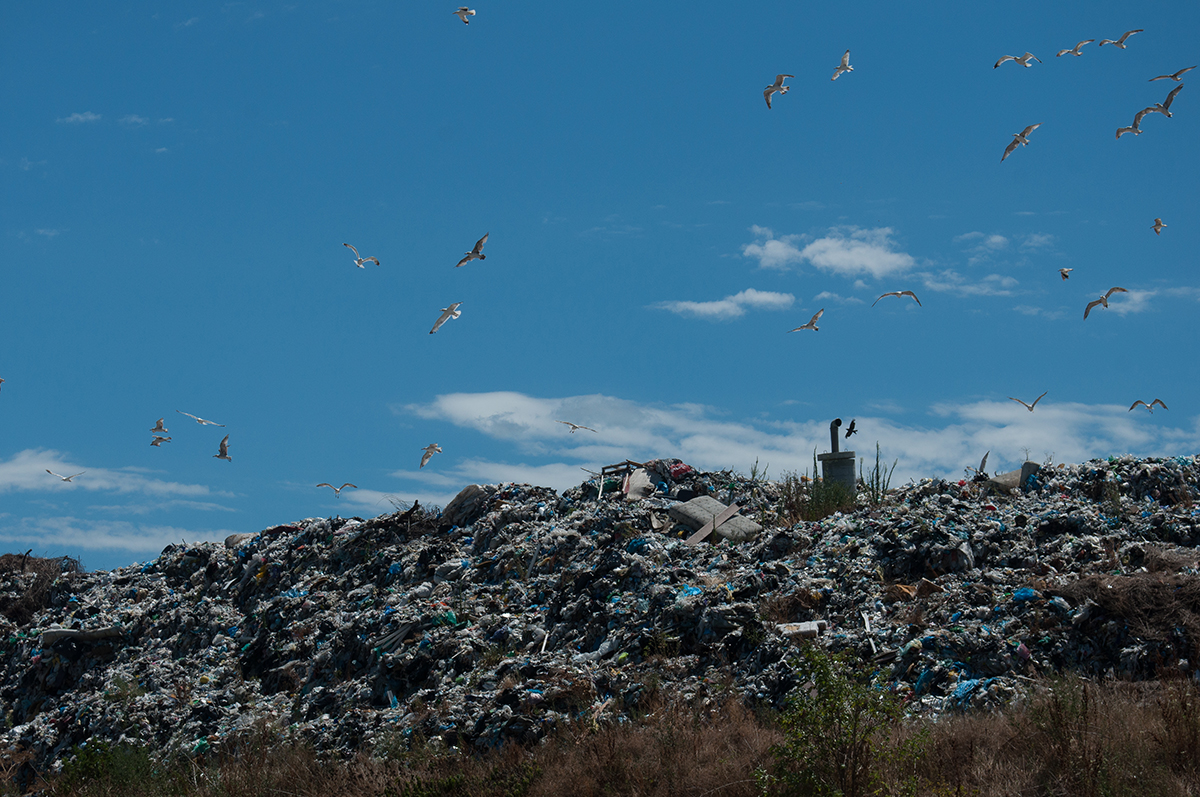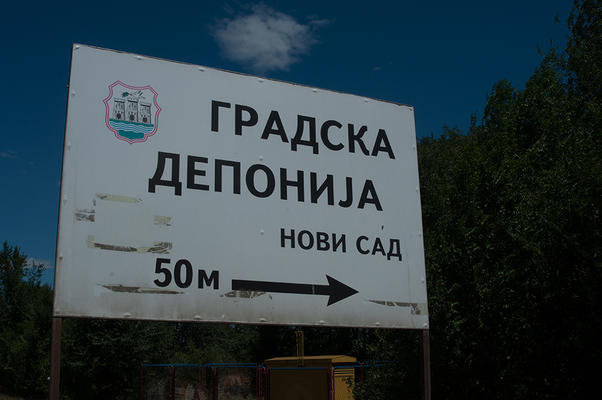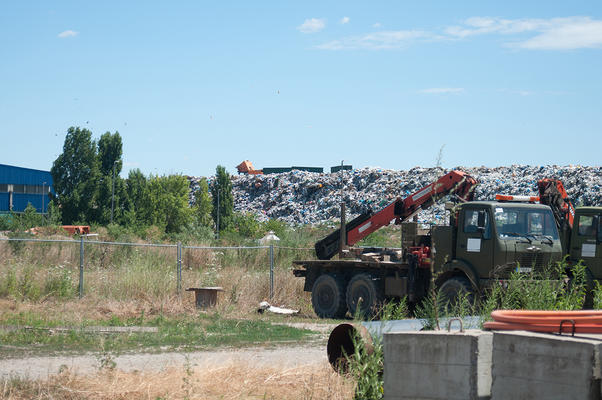
Photo: Dragana Prica
Serbia will need at least 918 million € to regulate the area of waste disposal. One of the main projects involves construction of regional landfills, that is, closing of the existing non-sanitary landfills which jeopardize human health
(Originally published by CINS , 7th of September 2017)
Although summer time provides ideal weather to dry the laundry outdoors, drying ropes in the yards of the Novi Sad suburb Klisa are empty. It is obvious that the houses are inhabited though windows are closed, while the streets seem deserted. The air is imbued with the odor of burned tyres and stale municipal waste.
The settlement comprises several streets in the vicinity of the highway, less than a kilometer away from the town landfill by air. Sojourn in this part of the town calls of an exceptional ability to hold breath and tolerance of odors, as experienced by the journalist of the Center for Investigative Journalism of Serbia (CINS).
“I have a daughter-in-law, and she cannot leave the laundry to dry outside. When you call the inspection, they say they’ll come tomorrow”, says Dušan Tegeltija, an inhabitant of the settlement.
He adds that he was told in the local community that these issues cannot be resolved by either the town or the Province, but that the place is intended “for some regional landfill, and that it is none of our business.”
The landfill mentioned by Tegeltija is the regional landfill, that is, regional waste management centre which is to be developed by extension of the already existing landfill so as to resolve the issue of waste management in Novi Sad and the municipalities of Temerin, Žabalj, Vrbas, Beočin, Bački Petrovac, Bačka Palanka, and Srbobran. Once it starts operating, municipal landfills are to be closed.
Although the new landfill was planned to be constructed in 2014, the construction work has not yet started, while since 2010 the City of Novi Sad has adopted just a few documents, such as waste management plans and detailed regulation plans. At the moment, the planned construction site is also an issue – Novi Sad has allocated the amount of six million dinars for the purpose of confirmation of the selected site or other sites.
Unlike the current landfill, in the waste management centre, waste would be separated for recycling, while residue would be disposed of at the sanitary regional landfill, without causing pollution of the environment. Here it is primarily about waste from households, public areas and production processes, while hazardous waste is intended for export or temporary storing within the company premises.
Serbia is making slow progress in implementation of regulations in the area of waste management. On two occasions it was planned to construct a larger number of regional landfills, but so far only eight have been established, some of which have not started operating yet, while some do not operate with their full capacities.
Igor Jezdimirović is the President of the association Environmental Engineering Group which, among other, is active in protection of water and nature, and waste management. According to his words, it is possible that no one will be held accountable that the regional landfill in Novi Sad is still not in operation.
“Before this is solved, establishing of responsibility of those who pass plans for their implementation or non-implementation, we are getting nowhere. And the pollution is constantly growing”, says Jezdimirović.
The disputable site
Serbian Waste Management Strategy from 2003 defined 29 regional landfills to cover the territory of 160 municipalities. The new Strategy, for the period 2010 - 2019, introduced the term “regional waste management centres”, which implies construction of regional landfills, plants for separation of recyclable waste, transfer stations, and composting plants. The Strategy defines 26 such centres.
As it is given in the state Strategy, not all towns are equally exposed to issues in this area, thus “the only economically justified solution is to establish regional centres” in which waste collected from several municipalities would be separated for recycling, while residue would be disposed of at regional landfills.
One of such landfills should have been constructed for the territory of Novi Sad and the municipalities mentioned. It has been almost six years since the Town assembly adopted the Regional waste management plan which envisaged its construction. To the present date, only a few documents have been adopted, at the cost of 6.5 million RSD. The construction works have not yet started.
It was envisaged that the new landfill is developed by extension of the existing one. The CINS journalist found no signs or information about future construction at the site.
According to the Regional plan, the landfill was to start operating in 2014, while the total costs of construction were estimated at 17.75 million €. It was also proposed to establish a separate company to manage the sanitary landfill.
Unlike the data from the Regional plan, in the Novi Sad Sustainable Development Strategy, costs of establishment of the regional waste management system were estimated at about 28.28 million €, while the period from 2016 to 2020 was determined as the timeline.
The new landfill, that is, the regional centre, should also resolve the issues such as storing of waste at inadequate official landfills, and forming of illegal dumps. In this area, there are 74 illegal dumps, as shown by the most recent data available – dating back from 2011.
In the very end of the previous year, the Assembly of Novi Sad adopted the Programme of investment activities for the construction of the regional waste management centre in 2017. According to this programme, in 2017 the City of Novi Sad should allocate the total of 11 million dinars: six million for the study to confirm the selected site or potential sites, four million for technical documents, and one million to obtain permits and construction approvals.
In August 2017, City Administration for Municipal Affairs concluded a contract with the company Hidrozavod DTD on the development of a “study of explorative works to confirm the selected site or potential sites “.
Igor Jezdimirović from the organization Environmental Engineering Group explains why the selected site presents a potential issue: “Ground waters are one of the issues. Secondly, it is the vicinity of the settlement Klisa and the first houses. On the other hand, power transmission lines are also close. And there is also the visual issue, the first thing one sees when entering Novi Sad is a growing heap of waste.”
Temerin is one of the municipalities whose waste is to end up at this landfill. According to Svetomir Stojanović, director of PUC Temerin, the company suffers financial losses because the construction of the regional landfill is postponed.
“As we still cannot even say for certain where the site for the new regional landfill will be, last year we had to build a rampart to prolong landfill lifetime. The improvement of the landfill was worth about 50 million dinars”, says Stojanović.
Officials of the Town administration of Novi Sad did not want to talk to CINS journalists; however, following a request for an interview filed to them, they sent an official letter in which, among others, they state that the town has initiated “activities aimed at preparation of the project for co-financing of works on construction of the Regional waste management centre”, that Partial pre-feasibility solid waste management study has been composed, and that “Pre-feasibility study development activities with the site selection methodology continue.”
According to Dejan Ubavin, director of the Department of environmental engineering at the Faculty of technical sciences in Novi Sad: “Professional audience does not find it clear why we have to wait for this for such a long time, what is the need for procrastination”
Impact on human health
Uncontrolled disposal of waste on landfills has negative impact on the environment, but also on human health, especially of those who live in the vicinity. According to 2012 data, almost all landfills in this region are located close to settlements, while the fact that many of them do not have any environmental protection measures presents additional issue.
Due to the fact that substances such as sulphur-dioxide, carbon-dioxide, vinyl-chloride and benzene, but also lead, are emitted from landfills to the environment, people who live in the vicinity are exposed to increased risk of pulmonary and respiratory diseases, as well as harmful impact to their immunity and central nervous system.
“Increased concentration of pollutants in the air, water, and soil may contribute to deterioration of health status of already afflicted persons, especially when it comes to respiratory organs, the heart and blood vessels, and the digestive tract (due to consumption of polluted food and water)”, explains Sanja Bijelović from the Institute of public health in Novi Sad.
There are numerous manners in which non-sanitary landfills may have impact on human health, for instance, by spreading of contagious diseases by flies, rodents, insects, and other animals.
Klisa - the settlement in Novi Sad is mostly inhabited by elderly people and families with young children, but this is difficult to notice at a glance. There are few children playing on the streets, while senior citizens avoid spending time outdoors, as, they say, they find it difficult to breathe.
The inhabitants of Klisa interviewed by CINS journalist say that they are mostly worried for their children’s health, but that they also feel that nobody is sympathetic to their troubles, and that they have no one to complain to. Some add that they feel as if they are second-rate citizens.
Except for hazards to health, the vicinity of the landfill also implies hazards from fires and damages.
“Landfill gas, which is mostly methane, is flammable”, says Igor Jezdimirović and adds: “In normal countries, landfill gas is used to produce power which is sold as renewable energy. As Serbia’s decision-makers are not capable of taking care of this, waste is burned, which causes air pollution. This is not a matter of resources. It is a matter of knowledge and willingness”.
Sources from Novi Sad City administration for inspection state that in the period from 30 August 2014 to 30 August 2017 they received ten citizen complaints, mostly because of odors, air pollution, and existence of illegal dumps beside the town landfill. Sources from PUC Čistoća add that they eliminate illegal dumps regularly, that the waste management at the landfill is conducted in line with regulations, and that they perform regular monitoring.
Dejan Ubavin from the Faculty of technical sciences in Novi Sad says that negative impact for the population may be minimized with good management: “With the regional, that is, sanitary landfill, which was planned, if it is managed adequately, such issues should not be arising.”
Establishment of regional landfills and waste management in general are also important in the process of Serbia’s accession to the European Union (EU). This area is a part of the negotiating Chapter27, which has not been opened yet.
Serbia will have to make considerable improvements in the area of environmental protection, which implies changes of existing practices and adoption of a range of new regulations. According to announcements of representatives of Serbian institutions, this would cost at least 10 billion €. To resolve the issue of landfills alone, it is necessary to allocate about 918 million €.
Domestic legislation is to be harmonized with the EU Landfill Directive by the end of 2018. Sources from the Ministry of environmental protection estimate the directive as “demanding in terms of implementation”, stating the year 2032 as the deadline.
“One of the topics to be negotiated with the Commission is definition of an appropriate transitional period (end deadline) for Serbia in terms of closing and reconstruction of existing dumps/landfills and construction of new waste management centres in accordance with the directive (including the landfills which have already been harmonized)”, as listed in the document of Serbia’s Negotiating group for Chapter 27.
Only one regional landfill is fully functional
According to the data of the Environmental protection Agency, only eight regional landfills have been established in Serbia, while three are still under construction. The constructed landfills are located in Užice, Sremska Mitrovica, Pančevo, Leskovac, Jagodina, Pirot, Lapovo, and Kikinda. Only one of them has permits for all five waste management activities (collection, transport, storing, treatment, and disposal) – the landfill Duboko in Užice.
The regional landfill in Pančevo started operating in 2015, 24 years as of the beginning of implementation of the project and upon the investment of 393.6 million dinars. The plan was to replace the old, non-sanitary landfill, which was much closer to the town; however, about one third of all collected waste ends up at the old landfill, which CINS already wrote about.
As many as 13 “regions” comprising two or more municipalities or towns have not yet even adopted regional waste management plans.
CINS journalists contacted the Ministry of environmental protection on several occasions and tried to talk to the Head of the waste department Radmila Šerović or other collocutors. They were always told that an interview is subject to a necessary approval, which has not been received more than a month and a half later.
Dejan Ubavin from the Faculty of technical sciences in Novi Sad says that the practice of keeping waste at landfills for decades, as is done in the majority of municipalities in Serbia, “has nothing to do with management – this is waste non-management”.


















 To Top
To Top